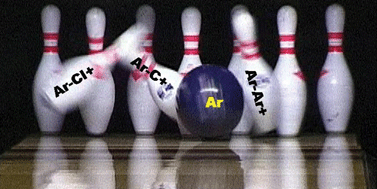An accurate and simple method for the determination of total arsenic, total selenium and total chromium in urine has been developed using inductively coupled argon plasma-dynamic reaction cell-mass spectrometry (ICP-DRC-MS). Determination was by external calibration, using matrix-matched standards and high purity calibration materials from a commercial vendor. Aliquots of each urine specimen were diluted (1 + 9) with 2% (v/v) nitric acid containing rhodium and iridium as an internal standard. Argon cell gas was used to remove the isobaric interferences that normally adversely affect 75As, 78Se and 52Cr analysis by ICP-MS and require the use of a dynamic reaction cell (DRC). The principle isobars that interfere with these measurements are [40Ar35Cl]+, [40Ar38Ar]+ and [40Ar12C]+ for 75As, 78Se and 52Cr, respectively. The counts at m/z 75 (arsenic); 78 (selenium); 52 (chromium), 103 (rhodium), and 193 (iridium) were measured. The ratios of the counts at m/z 75 or 78 to those at m/z 193, and m/z 52 to those at m/z 103 were calculated. These ratios were compared with those from urine-based calibration standards to calculate the arsenic, selenium, and chromium concentrations in unknown specimens. The concentrations of arsenic, selenium, and chromium were calculated as μg L−1 in the sample. No creatinine corrections were made, although these could easily be made with data for urine creatinine for each specimen. The proposed method uses the same diluted urine solutions prepared for conventional ICP-MS toxic metal biomonitoring and chemical terrorism screening analysis with the same internal standards; and uses argon as the DRC cell gas. The proposed method provides the basis for an accurate method for determining total arsenic, total selenium, and total chromium in unexposed subjects, and in persons considered to be exposed to those elements through chemical terrorism, environmental, nutritional or other pathways. Approximately 100 specimens, including blanks, calibration standards and quality-control materials, can be processed in an 8 h day.


 Please wait while we load your content...
Please wait while we load your content...